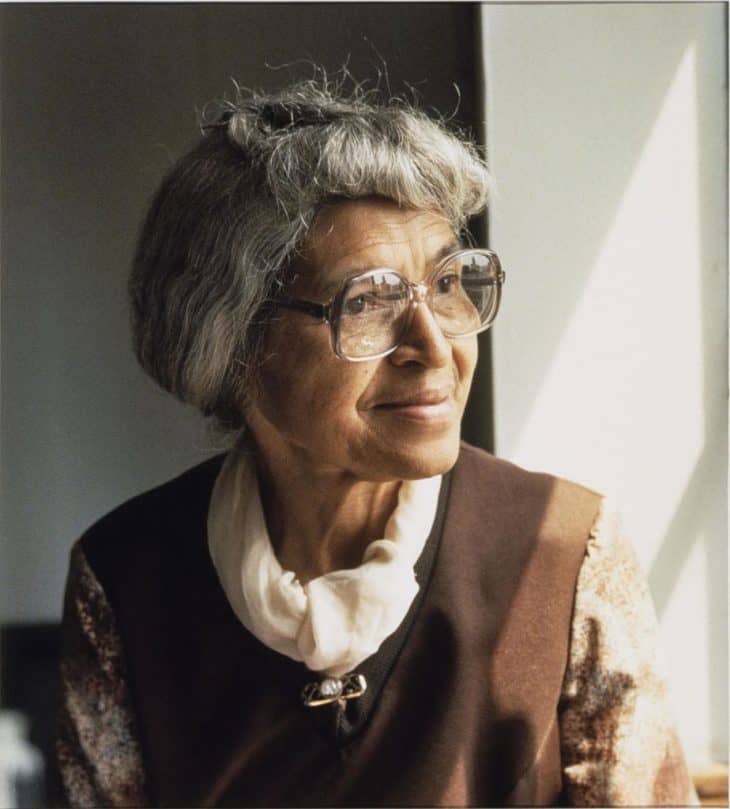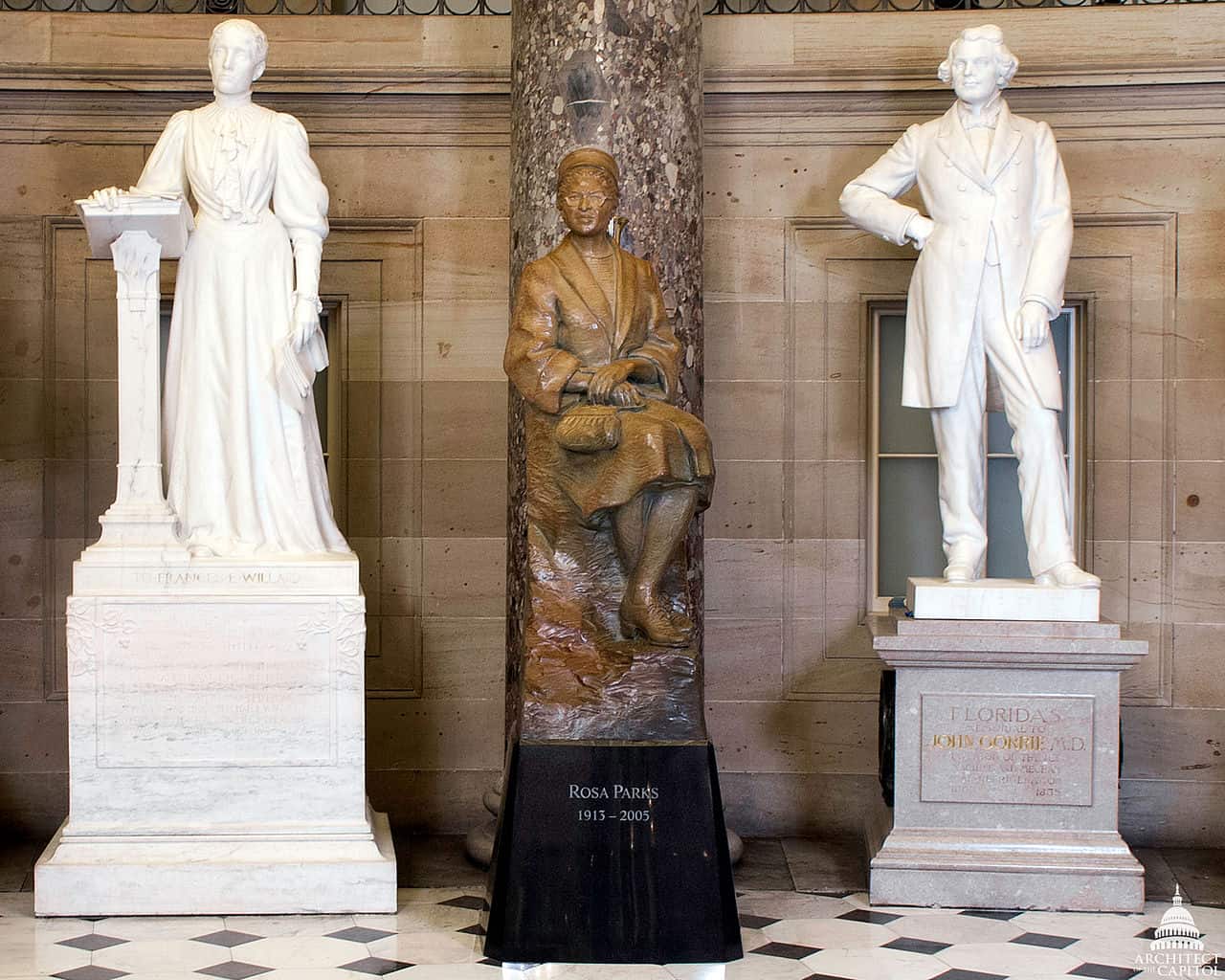
Also known as “The Mother of the Civil Rights Movement,” Rosa Parks fought for racial equality starting by refusing to give up her bus seat in Montgomery, Alabama.
Why was this such a big deal? During that time, the law required a black person to give up their bus seat to a white person. Violating this law incurs an arrest, and Rosa Parks is one of the most momentous figures of this subject matter. When the authorities arrested Rosa Parks on December 1, 1955, it stirred up a massive boycott, – setting so many things in motion.
Parks is one of history’s most prominent and inspiring women. She stood up for what she believed in – even though she was standing alone. Her one single act of defiance turned into a defining moment for the modern American civil rights movement. Evidently, Rosa’s life was far from perfect. She was jailed and ridiculed for her beliefs. But these things didn’t cripple her beliefs. Her story is proof that you only need the fire within you to make a difference.
Nowadays, black people are able to live like equals to whites because people like Rosa Parks made a stand. To quote a popular song, “It only takes a spark to get a fire going. And soon all those around can warm up in its glowing.” Think you know all there is to know about Rosa Parks? This Rosa Parks facts list will surprise you about the things you didn’t know about the historic woman. Get to know more about her by reading this comprehensive collection of Rosa Parks facts.
- Rosa was born on February 4, 1913, in Tuskegee, Alabama, United States.
- Rosa Parks only had one brother, Sylvester James McCauley.
- At the age of 16, she stopped going to school to aid her dying grandmother and her very sick mother.
- Rosa was only 19 years old when she married Raymond Parks.
- In contrast to Rosa who had no children, her brother, Sylvester had 13 children.
- Rosa Parks’ full name is Rosa Louise McCauley Parks.
- Rosa Parks was a civil rights activist.
- Her husband, Raymond Parks, was a barber.
- Rosa and Raymond Parks did not have any children.
- Rosa’s father, James McCauley was a skilled carpenter and stonemason.
- Rosa’s mother, Leona McCauley, was a teacher.
- Rosa Parks is famously known for her influential role in the Montgomery Bus Boycott.
- The Montgomery Bus Boycott was a social and political movement versus the system of racial segregation on Alabama’s public transit system.
- Rosa Parks was part of the civil rights movement.
- The civil rights movement in the US was a campaign for the struggles of African-Americans that wish to end the institutionalized racial discrimination and racial segregation in the country.
- Rosa’s parents, James and Leona McCauley, got separated when she was still a little girl.
- Rosa and her brother Sylvester grew up under their mother and maternal grandparents’ care and stayed on a farm in Alabama.
- Rosa’s brother served in the army during World War II and later worked in the Chrysler Motor Company. He did some carpentry work on the side.
- As a young girl, Rosa loved to study and she was a hard-working student as well.
- The United States Congress gave her the nicknames; “the mother of the freedom movement“ and “the first lady of civil rights.”
Rosa's family was part of AME's congregation.
Rosa’s grandparents, mother, brother, and Rosa herself were all members of the AME or African Methodist Episcopal Church. The AME is the first independent Protestant denomination established by the black people in Philadelphia, Pennsylvania, during the early nineteenth century.
Black students had to walk to school.
Rosa would recall that trains and bus companies required separate sections for whites and blacks. Only the white students have school buses that would bring them to school, whereas the black students had to walk to theirs.
"There was a black world and a white world." - Rosa Parks
According to Rosa, the white students have new schools while the black’s education is often underbudgeted. She once recalled that she used to see buses filled with white people pass by her every day. Rosa was quoted saying, “The bus was among the first ways I realized there was a black world and a white world.
The young Rosa experienced bullying in her neighborhood.
The young Rosa Louise McCauley experienced bullying in her neighborhood coming from white children but she would normally fight back. Rosa remembered that she would never accept physical abuse and that she would often come back with some form of retaliation.
Some of the white people are good to black people.
There is a record of the kindness of white strangers told in some pages of Rosa’s autobiography. But still, the majority of the experiences she recounted came from racism in her society, especially during the Ku Klux Klan. The Ku Klux Klan was the infamous hate group of white American supremacists who targetted African-Americans, Jews, immigrants, leftists, homosexuals, Catholics, and Muslims.
Racism is rampant in Rosa's era.

Rosa once recalled a terrifying moment of her life in which the Ku Klux Klan (KKK) roamed the street in front of her house. Her grandfather was holding a shotgun while guarding their front door. All while the supremacists burn the Montgomery Industrial School, a school for black children.
Rosa Parks continued her studies after marriage.
When Rosa married Raymond Parks in 1932, she took several jobs such as a hospital aide and domestic worker. Raymond Parks inspired Rosa to continue her studies and helped her to finish high school. During those times, only less than 10% of the African-American population had a high-school diploma. Rosa parks facts that will make you proud!
Raymond Parks was a member of the NAACP.
Rosa Park’s husband, Raymond, was a member of the National Association for the Advancement of Colored People (NAACP). NAACP is a civil rights organization in the US that advocates justice for African Americans. At that time, NAACP was raising money to help the defense of the Scottsboro Boys, a group of African American teenagers, ages 13 to 19, accused of raping two white women.
The NAACP chose Rosa Parks to be its secretary.
In the early ’40s, Rosa became more and more involved in the civil rights movement and later joined the NAACP in December 1943. The organization elected Rosa Parks as the secretary. According to her, she was too timid to turn it down so she accepted the position.
Rosa Parks worked as the NAACP's secretary for nearly 15 years.
Rosa worked as NAACP’s secretary until the year 1957. As a secretary, she helped the investigation of the Recy Taylor gang-rape case. She also organized the “Committee for Equal Justice for Mrs. Recy Taylor.” The committee later became known as “the strongest campaign for equal justice to be seen in a decade.”
Rosa was arrested for not giving up her seat on the bus.

On December 1, 1955, Rosa Parks resisted the order of bus driver, James F. Blake, to give up her seat for a white passenger. As a result, Rosa was arrested for violating an Alabama law that required black people to give their seats to white people when a bus is full. NAACP president Edgar Nixon and the leader of the Pullman Porters Union Clifford Durr bailed Rosa Park about 9:30 p.m. that same evening.
Rosa Park's arrest became a blessing in disguise.
Rosa Park’s arrest became an eye-opener for most black people which led to a year and 16 days of boycott against the Montgomery Area Transit System. This was a big deal because two-thirds of Montgomery bus passengers are African-American! By 1956, the Supreme Court finally decided to forfeit the segregation on public transportation, ending the racial discrimination in the transport system.
Rosa didn't want to give in anymore.
In contrast to what many people believed transpired, Rosa did not give up her seat because she was tired, but rather she was already tired of “giving in.” She also said that she was not that old at that time. This is one Rosa Parks fact to remind you to fight for what you truly deserve.
The Women's Political Council was the first group to officially promote the boycott.
NAACP president Edgar Nixon consulted with Jo-Ann Robinson regarding Rosa’s arrest. Robinson is a member of the Women’s Political Council and Alabama State College professor. Jo-Ann Robinson knew right away that they need to use the case as an opportunity for a boycott movement. All night, Robinson mimeographed more than 30,000 handbills advertising the bus boycott, making the Women’s Political Council the first group to officially promote the boycott.
Rosa Parks went back to jail again a few weeks after her first arrest.
The reason for her second arrest was her pivotal role in sparking the Montgomery Bus Boycott. She started working part-time as a dispatcher arranging a ride-sharing system for people participating in the boycott.
Many cities commemorated her arrest's 50th anniversary on December 1, 2005.
To acknowledge and honor Rosa Parks’s 50th anniversary of her arrest, transportation authorities in cities such as Washington, D.C., New York, and other cities left their bus seats empty to commemorate her momentous act of defiance.
Rosa Parks died on October 24, 2005.
On October 24, 2005, Rosa Parks died of natural causes at 92 years old in her Detriot apartment. Raymond Parks died of cancer on August 19, 1977. Rosa has always been close to Raymond’s sister, her nephews, nieces, cousins, and their families. This is probably because she and Raymond never had a child.
Angela Bassett played Rosa Parks in the film, The Rosa Parks Story.
On February 24, 2002, CBS aired the TV movie, The Rosa Parks Story, directed by Julie Dash and written by Paris Qualles. It won several awards at the Black Reel Awards, an annual American awards ceremony, and the NAACP.
You can find the Rosa Parks statue in the National Statuary Hall.

The Rosa Parks statue was placed in the National Statuary Hall. The National Statuary Hall is a chamber in the United States Capitol that is dedicated only to the statues of prominent Americans. Rosa’s sculpture here portrays her sitting on a rock-like formation, symbolizing her refusal to give up her bus seat in the year 1955. Along with her in the chamber are George Clinton, Ronald Reagan, Samuel Adams, Lewis Cass, John James Ingalls, George Washington, and so much more.
Rosa Parks was the first woman to lie in honor at the U.S. Capitol.
Rosa Parks was the first woman to lie in state or honor at the U.S. Capitol. When Rosa died, her body was brought to the U.S. Capitol where her final tribute was done. At least 50,000 people filed to her casket to give their respects and to witness her for one last time.
Was this page helpful?
Our commitment to delivering trustworthy and engaging content is at the heart of what we do. Each fact on our site is contributed by real users like you, bringing a wealth of diverse insights and information. To ensure the highest standards of accuracy and reliability, our dedicated editors meticulously review each submission. This process guarantees that the facts we share are not only fascinating but also credible. Trust in our commitment to quality and authenticity as you explore and learn with us.
